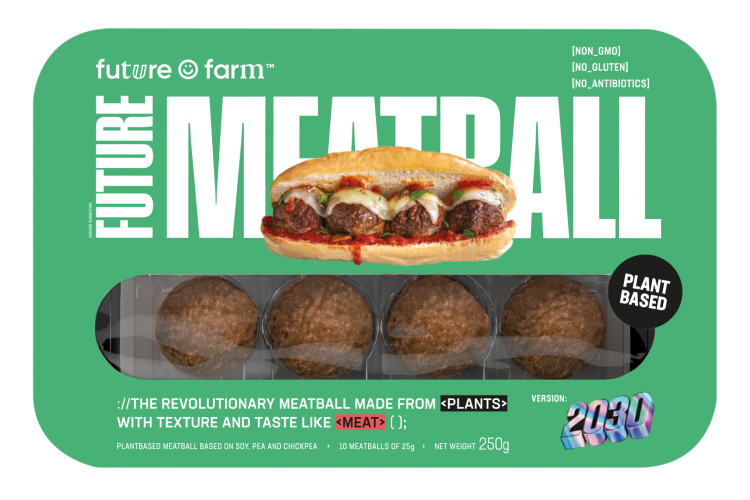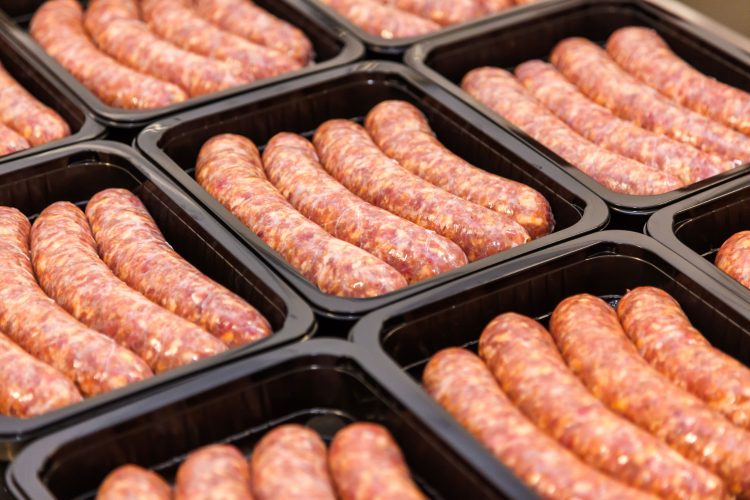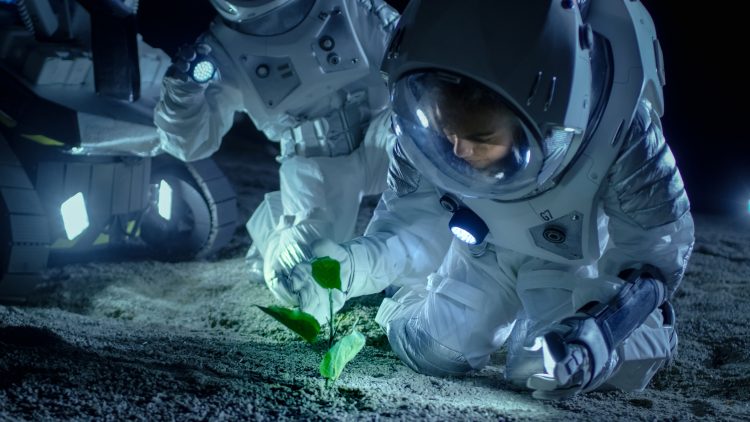Plant-based: the big debate
- Like
- Digg
- Del
- Tumblr
- VKontakte
- Buffer
- Love This
- Odnoklassniki
- Meneame
- Blogger
- Amazon
- Yahoo Mail
- Gmail
- AOL
- Newsvine
- HackerNews
- Evernote
- MySpace
- Mail.ru
- Viadeo
- Line
- Comments
- Yummly
- SMS
- Viber
- Telegram
- Subscribe
- Skype
- Facebook Messenger
- Kakao
- LiveJournal
- Yammer
- Edgar
- Fintel
- Mix
- Instapaper
- Copy Link
Posted: 16 August 2021 | Bethan Grylls (New Food) | No comments yet
With our health and that of the planet’s vying for supremacy in consumers’ minds, New Food’s Editor looks at the arguments surrounding the meat vs plant-based debate, including misconceptions over processing and space farming.


As consumers seek ‘better’ options for their health, the environment and animal welfare, an assortment of myths have emerged. And it’s not surprising – we are bombarded with messages every day, some of which are founded and others which are not, so it can be difficult to sort the fake news from the facts. Moreover, when one piece of research states one thing, you’re bound to find another that contradicts it.
One such misconception to have arisen surrounds the term ‘processed’ and what it actually means. There are numerous reports which have provided evidence stating that ultra-processed food is linked to higher rates of obesity and even mortality.1,2 With reports suggesting that more than half of calories we consume in the UK and Canada are from ultra-processed foods,1,3 and 80 percent for the US,4 it’s no wonder that consumers are looking to avoid such labels.
The difference between processed and ultra-processed
The truth is that almost everything we eat is processed to some degree – the part to note is the degree of processing. The good news for consumers is that a system has already been devised for this – NOVA5 classifies food into four groups, these are as follows:
- Group One: Unprocessed or minimally processed
Unprocessed foods include edible parts of a plant, animal or fungi; for example, fruit, seeds, eggs and algae. A food becomes minimally processed when it is still natural but has been altered in some way, such as crushing, grinding, chilling and even vacuum packing.
- Group Two: Processed culinary ingredients
These are foods such as butter, oils, salt and sugar. They are substances derived from Group One or from nature by processes that include pressing, refining, grinding, milling and drying.
- Group Three: Processed foods
This group includes bottled vegetables, canned fish, cheeses and freshly made breads, which are created essentially by adding salt, oil, sugar or other substances from Groups One or Two.
- Group Four: Ultra-processed food and drink products
Sweets, soft drinks, reconstituted meat products and pre-prepared frozen dishes are all examples of ultra-processed foods. These aren’t modified but instead are formulations made mostly or entirely from substances derived from foods and additives.
However, it can be difficult to identify whether a food is processed or ultra-processed. For example, bread made from wheat flour, water, salt and yeast is processed. It becomes ultra-processed when elements such as emulsifiers or colourings are added.6
Is plant-based food ultra processed?
You will most likely be familiar with the argument that a plant-based diet is healthier for you and for the planet;7 for example, 20 servings of vegetables have fewer greenhouse gas emissions than one serving of beef8 …but there’s always two sides to these things.
While some are beating the plant-based drum, others are suggesting these foods are not always as healthy as they appear, due to the way they are often processed. In fact, a study found that higher avoidance of animal-based foods was associated with a higher consumption of ultra-processed food.9
Furthermore, according to an article in The Conversation, soy protein (one of the most common meat analogues in plant-based foods) actually contains levels of nitrates that are comparable with bacon.10 In very basic terms, nitrates in processed foods are near to amino acids and it is their reaction with this organic compound that can result in the formation of N-nitroso, which can cause cancer.11,12
More than half of calories we consume in the UK and Canada are from ultra-processed foods.
“I believe that some in the meat sector are pushing this perception that plant-based can be bad for you and, of course, there will be products which are ultra-processed and plant-based, and, indeed, bad for you,” Pedro Zuim, Marketing Director Europe & ROW at Future Farm told New Food. “But regardless, I believe the move away from meat is a positive one. It’s much better for the environment and for animals.”
He continued: “Future Farm is a clean label product – and we’re very proud of that. I personally don’t believe we should be eating ultra-processed foods, but equally, I’m not going to dictate what people should and shouldn’t consume.”


It’s the degree to which something is processed that consumers should be mindful of
Future Farm’s process, Zuim explained, is very simple and would fall into Group One of NOVA’s classification system. “It’s really just a case of mixing in vegetables and fruit and adjusting the temperature. We add some powders to mimic the colour of meat – there’s not much to it.” As such, this particular plant-based offering can be described as ‘clean label’ – a thriving market projected to be worth $64.1 billion by 2026.13
Clean label
There’s no legal definition of ‘clean label’ as of yet, and the industry and consumers alike remain confused over what determines a clean product. The terms which seem most often linked with ‘clean’ include ‘all-natural, GM-free and humane’ and a short ingredients list. Familiarity with ingredients is also a particularly popular notion with consumers.14 The latter, however, may be somewhat problematic, as Zuim explains.
“We use nine to 10 ingredients in Future Farm products, and although some of those names may be unfamiliar to a consumer, they’re all natural,” he said. “For example, you might read the word ‘methylcellulose’ on the back of our packets; it sounds unnatural but it’s actually a plant extract which helps with texture and is used as a gluten substitute. Another example is ‘ascorbic acid’; this is a natural preservative that helps extend shelf life.
“Eating is central to our lives, but as a consumer you’re not immersed in it. There’s this notion of ‘I don’t know that word, I should avoid it’. It’s not the consumer’s fault, there’s a lot of information out there.”
The protein argument
Another common subject in the meat/plant-based debate is protein.
Research from Betway Casino suggests that by 2050, most of our protein will come from either plant-based sources or cultivated meat. We’ve written before about the challenges of mimicking meat’s flavour before, and this is something which the company raises in its blog post too, before hedging its bets that the quality of such alternatives will improve immensely in the coming years as the market becomes ever more competitive.
“There’s a myth that meat is the best protein provider,” stated Zuim, “and a lack of knowledge around what amount of protein we should be eating. We need to stop looking at non-science-based blogs and Instagram influencers for the answer, because we are all different, unique beings.”
There are strong arguments for both sides: for example, scientists from the University of Arkansas claim that animal proteins have higher protein digestibility and a better essential amino acid profile relative to dietary requirements. According to this research, measures of protein quality indicate that animal proteins can more readily provide the daily requirement of essential amino acids than plant protein.15
Opposing arguments question whether – even if meat-based products do offer higher levels or better quality of protein – it’s worth the consequences. For example, while raw red muscle meat contains around 20–25g protein/100g16 it has also been linked to heart disease.17 Plant-based advocates contend that you can still obtain sufficient levels of protein from meat alternatives; 100g of edamame contains about 12g of protein, for example.18 To put this into context: for adults, an average requirement of 0.6g of protein per kilogram bodyweight per day is estimated. The Reference Nutrient Intake (RNI) is set at 0.75g of protein per kilogram bodyweight per day. This is approximately 56g/day and 45g/day for men and women aged 19-50 years respectively.19
The environmental impact of how we produce our protein is another consideration, with animal-based foods arguably taking a greater toll on the environment.8
Another very interesting point within the Betway blog is the appearance of future food. “By 2050, we will all be eating more fruit, vegetables and wholegrains, and a lot less meat, dairy and junk food. Yet some of the plants we eat will look nothing like the plants of today thanks to innovations within microorganism [eg, fungi, microalgae] cultivation and 3D printing,” the post reads.
This is a curious notion, considering how picky we as consumers can be around food aesthetics. Although concepts such as ‘wonky veg’ are picking up pace as the world begins to appreciate the impacts of food waste on our planet. So although it may be difficult to imagine food looking different to how it does now, we may be more accepting of such change should it be for the greater good.


Does our future lie on Mars or here on Earth?
Plants from outer space
Zuim believes that part of the answer to our climate crisis is plant-based and he’s not alone, with a significant number of experts and consumers being of the same mind. He criticised the current work of entrepreneurs Elon Musk, Jeff Bezos and Richard Branson who are all injecting large sums into space flight as “immature” and questioned why such funds weren’t being invested in saving Earth.
“Everything we love is here, we can’t even breathe on Mars. I find it curious as to why billionaires are investing so much money into it. Instead, we should be fixing the mess we have made here – and that can be fun and super tasty!”
But given the prediction that we have just nine years left to prevent irreversible damage from climate change,20 is it really such a bad idea to have a plan(et) B? Several years ago, NASA announced its plans for the Martian Garden, and testing is now underway to see how crops fair in an iron oxide–rich Martian soil simulant.21 NASA has also started ‘Veggie’, a luggage-case-sized garden located on the space station, examining how microgravity impacts plant growth; and the researchers have successfully grown a variety of foods, including lettuce.22 Looking at ways to produce life in the harsh environments of the Red Planet could also offer answers here on Earth as climate change starts to mimic Mars’ rough conditions. It will certainly be interesting to see where this research leads in a few years’ time.
Everything we love is here, we can’t even breathe on Mars.
Regardless of whether colonising space and growing crops on the Red Planet is the answer or not, Zuim said Future Farm’s focus will be on encouraging the plant-based shift by offering consumers products that compete with meat on taste and price.
“We’re always comparing our sales with meat because the goal for us is to make it the easy choice,” he said. “I think in the future we’ll see plant-based prices lowering and meat becoming more culturally displaced as our category matures and the benefits become more apparent.
“I believe plant-based is the right move, but ultimately it’s up to the consumer to decide what’s best for them. At some point, however, we’ll need to come together and decide: do we want to live on Earth or do we want to invest further in Mars.”
Biography


References
1. www.ncbi.nlm.nih.gov/pmc/articles/PMC5986467/
2. www.bmj.com/content/365/bmj.l1949?ijkey=49aed9b66cc0231c9ba9207ac5ddbbaf066a4e99&keytype2=tf_ipsecsha
3. www.heartandstroke.ca/articles/what-is-ultra-processed-food
4. www.sciencedaily.com/releases/2019/07/190725092534.htm
5. https://world.openfoodfacts.org/nova
6. www.bbc.co.uk/food/articles/what_is_ultra-processed_food
7. https://biblio.ugent.be/publication/8521128/file/8521129
8. https://ourworld.unu.edu/en/new-research-says-plant-based-diet-best-for-planet-and-people
9. https://nutrition.org/do-plant-based-ultra-processed-foods-improve-the-nutritional-quality-of-vegetarian-diets/
10. https://theconversation.com/plant-based-burgers-should-some-be-considered-junk-food-163514
11. https://progressreport.cancer.gov/prevention/nitrate#:~:text=When%20taken%20into%20the%20body,may%20cause%20cancer%20in%20humans
12. www.bbc.com/future/article/20190311-what-are-nitrates-in-food-side-effects
13. www.marketdataforecast.com/market-reports/global-clean-label-ingredients-market
14. www.ift.org/news-and-publications/food-technology-magazine/issues/2020/february/features/clearing-up-clean-label-confusion
15. www.newfoodmagazine.com/news/151272/are-all-proteins-equal/
16. https://onlinelibrary.wiley.com/doi/full/10.1111/j.1747-0080.2007.00197.x
17. www.hsph.harvard.edu/nutritionsource/what-should-you-eat/protein/
18. https://tools.myfooddata.com/nutrition-facts/168411/100g/1
19. nutrition.org.uk/nutritionscience/nutrients-food-and-ingredients/protein.html?start=2
20. www.un.org/press/en/2019/ga12131.doc.htm
21. https://ui.adsabs.harvard.edu/abs/2018AAS…23140106G/abstract
22. www.nasa.gov/content/growing-plants-in-space
Related topics
Environment, Health & Nutrition, Plant based, Processing, Sustainability, Technology & Innovation









